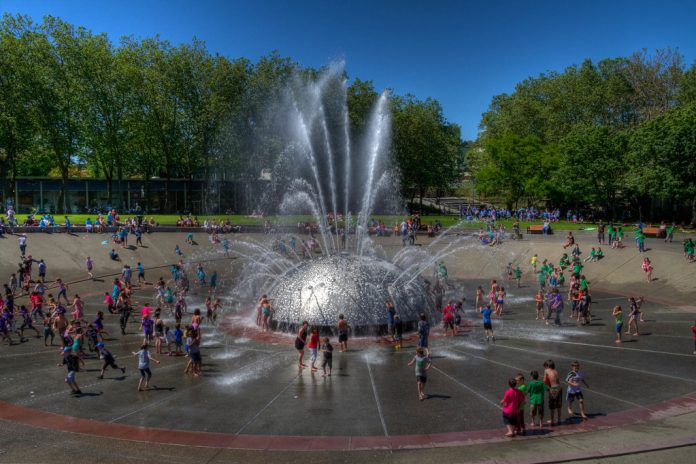
Research has identified strategies that can effectively combat the urban heat island effect.
As the current heat dome traps Seattle within its sweltering grip, it has become painfully apparent that as the climate changes, we will have to change as well. Weather events like heat domes, which occur when high-pressure atmospheric conditions combine with influences from La Niña, are expected to become more frequent — and more intense — as the Pacific ocean increases in temperature as a result of the climate crisis.
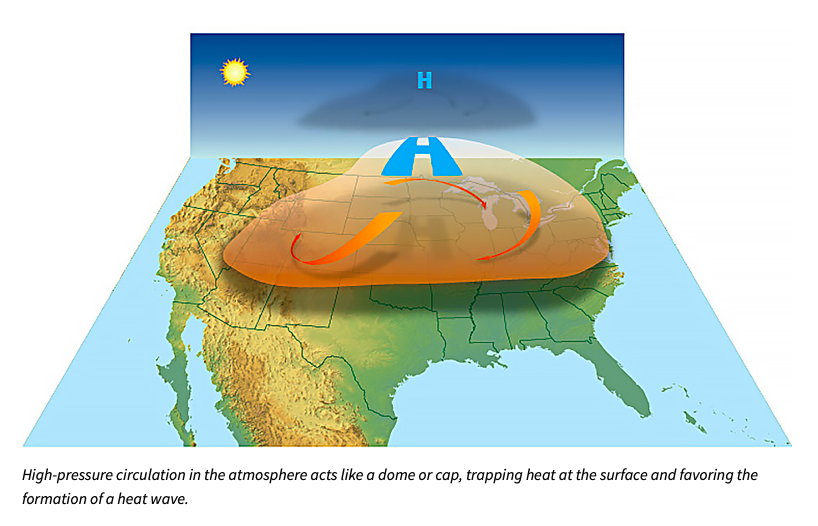
Not a pretty picture, right? The prospect of more frequent heat domes is just one more vivid reminder of the need to effectively adapt our cities to rising temperatures as we work to decrease the carbon emissions fueling the climate crisis. Rather than hide in air-conditioned buildings, which incidentally spew hot air outside, we need to learn how to live better with hotter temperatures. This situation is all the more urgent in cities where a phenomenon known as urban heat island effect can significantly ratchet temperatures up. According to data from the Environmental Protection Agency (EPA), daytime temperatures in urban areas may be 1°F to 7°F higher than temperatures in outlying areas, while nighttime temperatures may be 2°F to 5°F higher. These increases in heat are often most acutely felt in lower-income urban areas, which tend to have less tree canopy and fewer green spaces.
This trend can be found in Seattle as well. The city was ranked number ten in the nation for the biggest difference between urban and rural summer heat in report by Climate Central; additionally, an interactive map of urban heat island effect published by King County shows how the South End of Seattle and southern suburbs like Tukwila and Renton, all home to greater numbers of low-income and Black, Indigenous, and people of color (BIPOC) residents, suffer from higher than average urban heat impacts. These findings underscore the necessity of taking the issue of urban heat island effect seriously in our typically cool and rainy corner of the world.
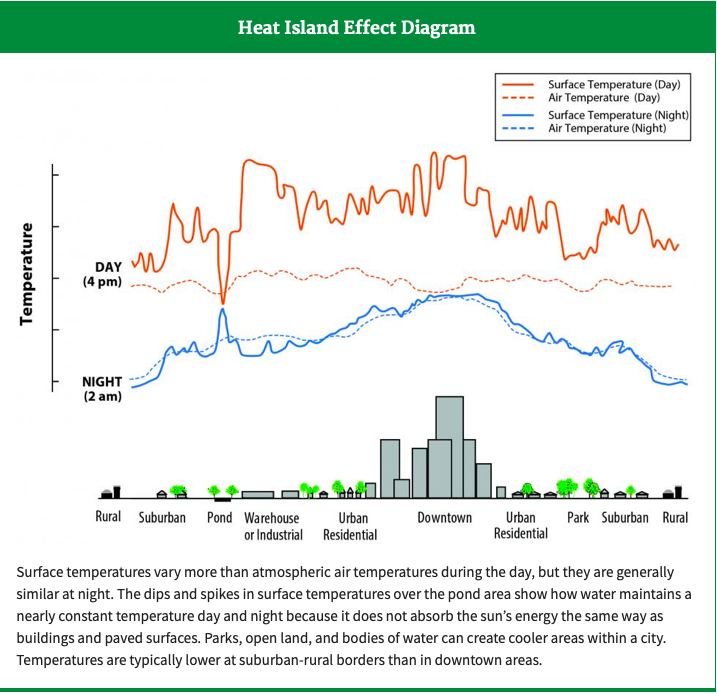
Fortunately, cities confronting hotter temperatures than Seattle’s have been experimenting with design techniques to combat urban heat island effect, and a growing body of evidence shows that these interventions can produce real cooling results. With increased awareness and deliberate, long-term planning, Seattle should be able to decrease existing urban heat inequities and become better equipped to face a hotter future.
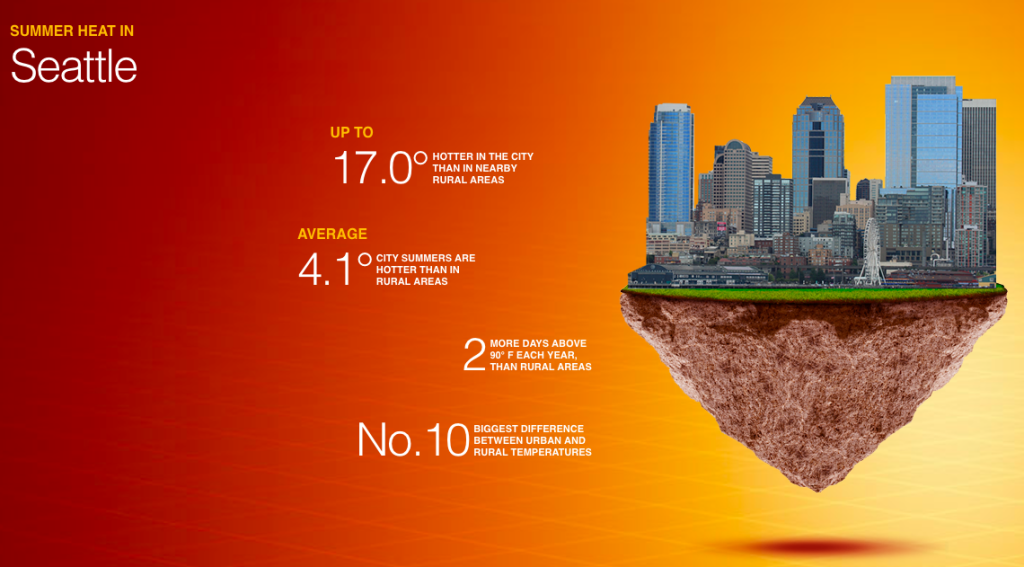
Is urban density to blame for heat islands?
The short answer is yes and no. Looking at the heat map recently published by King County, it is possible to easily point out the disparities that exist in the Seattle region. Looking at Seattle alone, it is clear that urban heat island is pronounced in areas with greater urban density. However, while it may be tempting to blame density for urban heat island effect, the reality is more complex.
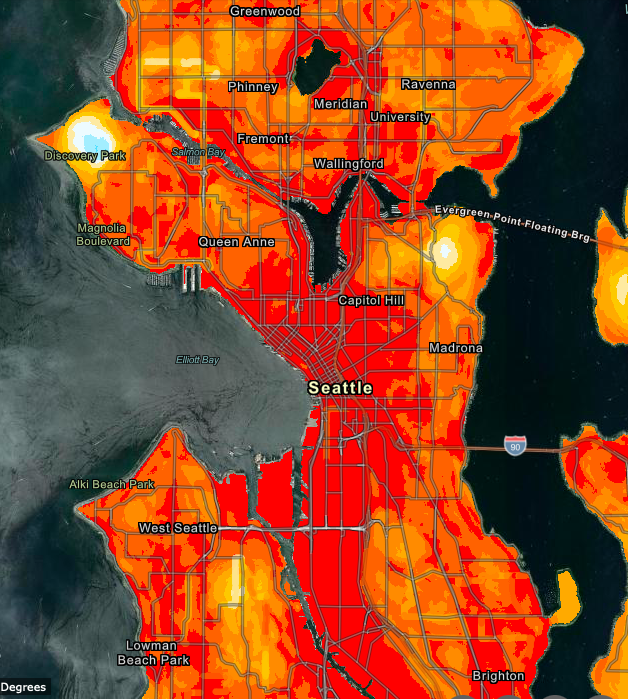
Urban heat island effect results from a variety of factors, density being one of them, but by far not the only. Suburban environments with wide streets, lots of paved parking lots, and low-rise strip mall type structures actually tend to register more urban heat island effect than higher density areas where tall buildings may provide shade. This explains why parts of south King County show high levels of urban heat impacts despite having low to moderate urban density.
According to Vivek Shandas, professor of urban studies and planning at Portland State University in Oregon, varying building heights, tree canopy cover, and streets widths all effect urban heat islands more than density alone. While studying methods for mitigating urban heat islands in Portland, which ranks fourth in the nation in Climate Central’s report, Shandas found that thoughtful design eliminate much of the urban heat island effect in dense environments. “It wasn’t about no buildings and all green,” said Shandas in an interview with Yale Environment360.
Cool roofs and pavements make a difference
Varying building heights, incorporating green roofs and walls into buildings, and narrowing street widths are all effective techniques for cooling dense urban environments, but installing cool roofs and using cool pavement materials have significant impact as well. According to the EPA’s handbook on combatting urban heat effect, roofs comprise nearly a quarter of land cover in most American cities.
Since about 52% of the solar rays that fall on Earth are felt as heat, the absorption of these solar rays by photovoltaic solar panels on rooftops may be one efficient way to remove ambient heat from the atmosphere, while transforming these solar rays into electric energy. Anecdotally, I’ve observed that the solar panel installed on my home seems to have an effect, with my unit remaining cooler inside on hot days than the two identical units it’s adjacent to.
However, research needs to be completed around the ambient heat effects of solar panels in large scale settings since at least one study found that very large photovoltaic solar arrays actually increased surrounding ambient temperatures by a few degrees.
But other methods of creating cooler roofs exist, one of which is to use white material. White roofs are actually more efficient at combatting urban heat island effect than green- or living-roofs, and they are cheaper to install and maintain. When comparing the three roof types, a 2014 Berkley study was enthusiastic about their promise. “White roofs win based on the purely economic factors we included, and black roofs should be phased out,” said study co-author Arthur Rosenfeld, a Berkeley Lab Distinguished Scientist Emeritus and former Commissioner of the California Energy Commission.
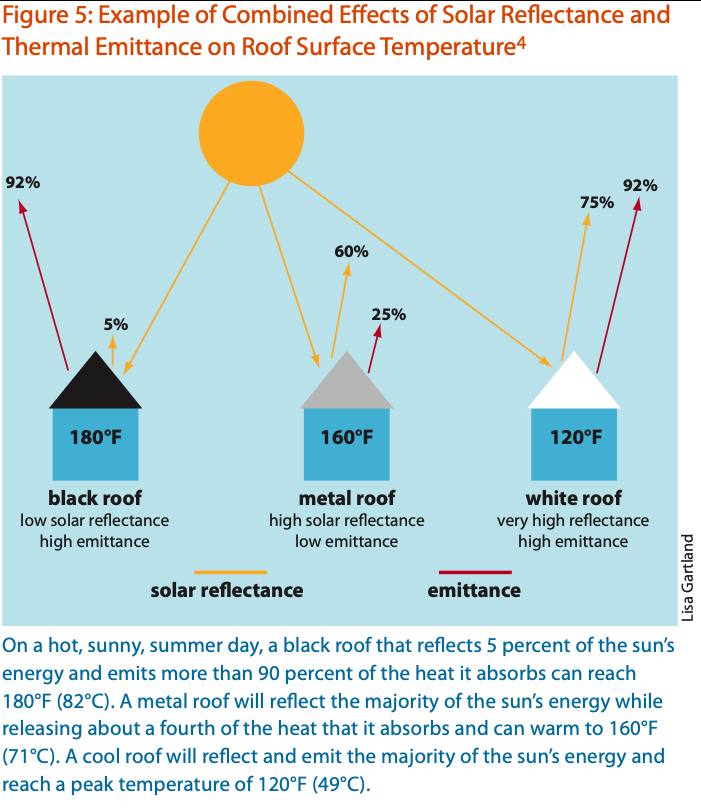
Cool pavement types should also capture our attention. It’s estimated that on average about one half of American cities’ surface area is taken up by pavement for roads, parking lots, private driveways, and more. Commonly used materials like asphalt and concrete are terrible for urban heat effect, a fact we all know too well. However, permeable pavements can produce evaporative cooling effects after having water applied, a technique being tested in Tokyo and Osaka, Japan. Vegetated permeable pavements, or pavement made with cutouts for grass or moss, are also promising, although they are most effective in cities with higher summer moisture levels and may not be appropriate in high traffic areas.
However, other cool pavement types exist as well. For instance, it is possible to cover asphalt with a highly reflective seal to help prevent them from overheating. A 2018 study in Green Energy and Technology found that pavement covered with a highly reflective seal reduced the heat island effects by five times when compared to conventional asphalt. A variety of different pavement seals exist, and some have been even made from tree resin to eliminate the use of petroleum-based materials.
Finally, decreasing the amount of pavement by reducing unnecessary parking areas and narrowing the widths of roads should also be a top consideration.
Tree canopy and green spaces reduce temperatures
Tree canopy and green spaces are quite effective in reducing temperatures. In fact, data from the EPA suggests that trees and vegetation can reduce daytime temperature by 2°F to 9°F. On top of providing shade, trees and other vegetation engage in evapotranspiration, a process by which water is transferred from land into the atmosphere, typically generating a cooling effect.
Trees and vegetation are most useful when they are evenly distributed and placed near buildings and paved areas. Researchers have also found that planting deciduous trees or vines to the west of buildings is typically most effective for interior cooling purposes, especially if they provide shade to windows and part of the building’s roof.
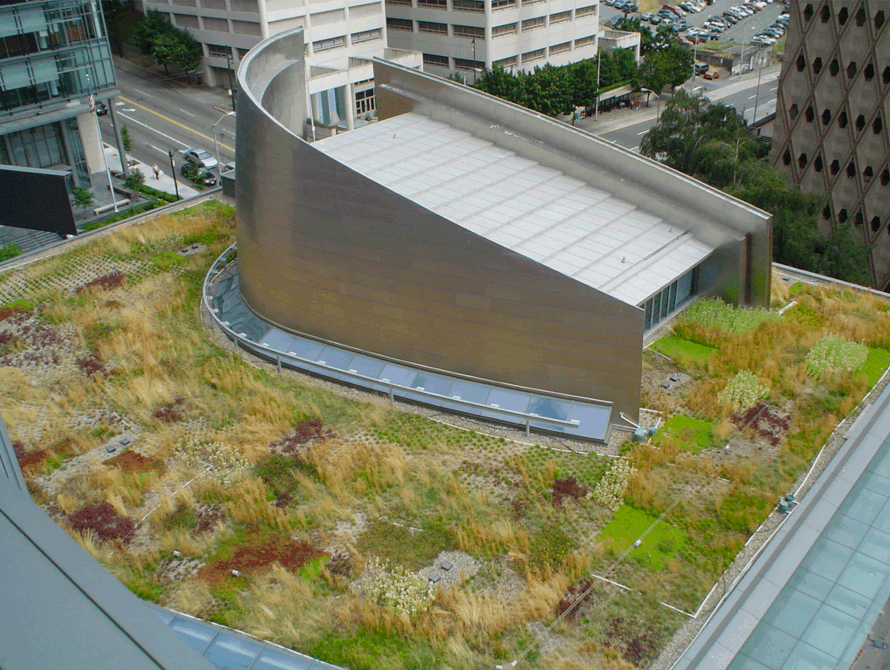
Unfortunately, ground level vegetation is less beneficial for reducing ambient heat in an area. Research shows that on a hot day grass and other ground cover can heat up almost as much as asphalt. Watering ground level vegetation do make a difference, but these effects are temporary and overwatering can harm the vegetation.
Incorporating green walls or facades and green roofs into the built environment are additional strategies that can be deployed urban settings where planting trees might not be an option. These options have been utilized in Australia, where concerns about urban heat island effect are significant. An experiment conducted on the thermal performance of a living wall in Adelaide revealed much lower temperatures when compared to a bare wall.
What is blue infrastructure and how can it cool cities?
Less well known than its counterpart green infrastructure, blue infrastructure is the incorporation of active or passive water elements into an urban landscape. It is been used to cool cities for thousands of years. For instance, in ancient Rome water carried by aqueducts was splashed onto pavement to generate a cooling effect.
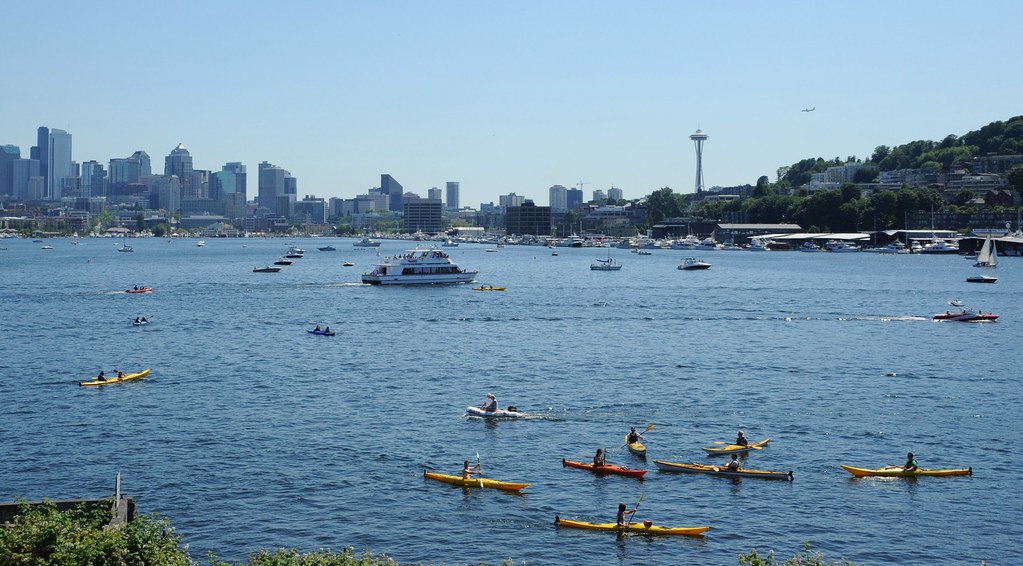
Research suggests that “blue spaces” such as rivers, lakes, wetlands, and bioswales can modestly reduce urban ambient temperatures as a result of their evaporative cooling and water heat retention properties. Active water elements like fountains and sprinklers may have an even more significant cooling effect. Anyone who has had the pleasure of getting caught by surprise by a sprinkler on a hot day understands how refreshing water can be.
Maximizing use of our existing blue infrastructure and devising strategies to add more blue infrastructure could be effective in Seattle, where water shortage is not as much of a problem as it is in cities like Los Angeles or Las Vegas. But it’s also important to be mindful of energy consumption when considering active water elements.
Designing for cooling takes long-term, comprehensive planning
As a city that struggles with both a hot, humid climate and soaring energy use, Singapore is engaging in serious comprehensive planning for decreasing urban heat island effect. One result has been the Cooling Singapore project, which is utilizing quantitative and qualitative research to better understand what factors are most responsible for heating up the city. The project team has identified 86 different urban cooling measures related to vegetation, urban geometry, water features and bodies, materials and surfaces, shading, transport, and energy. A PDF copy of their work is available online.
Overall, combining techniques seems to be the best way to decrease urban heat island effect. Studies completed in Australian cities have found that implementing multiple cooling techniques simultaneously can double their effectiveness. Fortunately for Seattle and other cities that have temperate, changeable climates, these techniques do not generally run counter to design principles for healthy, energy efficient, and equitable cities in all seasons.
Natalie Bicknell Argerious (she/her) is a reporter and podcast host at The Urbanist. She previously served as managing editor. A passionate urban explorer since childhood, she loves learning how to make cities more inclusive, vibrant, and environmentally resilient. You can often find her wandering around Seattle's Central District and Capitol Hill with her dogs and cat. Email her at natalie [at] theurbanist [dot] org.


